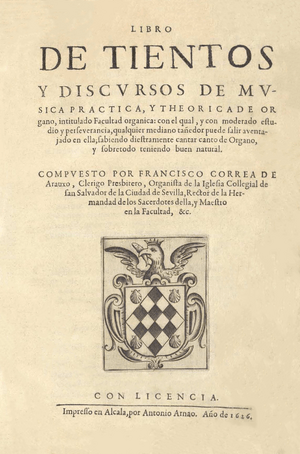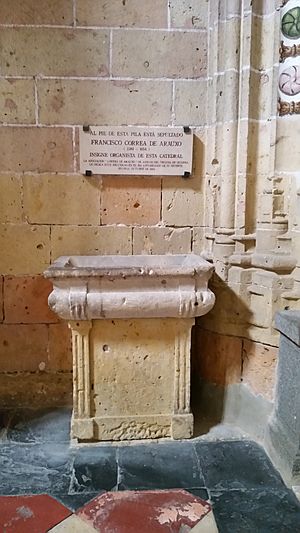Francisco Correa de Arauxo facts for kids
Francisco Correa de Araujo (also known as Arauxo or Acebedo) was an important Spanish musician. He was an organist, a composer, and a music expert. He lived from 1584 to 1654, during a time called the late Renaissance.
Contents
Life of Francisco Correa de Araujo
Correa de Araujo was born in the city of Seville, Spain. Like many musicians from his time, not all the details of his life are well known. For a while, even the exact years he was born and died were debated.
He learned about music theory by studying the works of other famous musicians. In 1599, he was offered a job as an organist in Seville. However, there was a disagreement with another musician, which delayed his official start for six years.
In 1608, he became a priest. He kept his job as an organist in Seville until 1636. He tried to get other jobs several times but was not successful. In 1630, he faced more legal challenges, which even led to a brief time in jail.
In 1636, he left Seville and took a new job at Jaén Cathedral. Four years later, in 1640, he moved to Segovia Cathedral. He stayed there for the last fourteen years of his life. He died in Segovia in 1654, facing financial difficulties.
Musical Works and Ideas
Correa de Araujo wrote about two other music books he planned to publish. However, all his surviving musical works are found in one important book. This book is called Libro de tientos y discursos de música practica, y theorica de organo intitulado Facultad organica. It was published in 1626.
This book is not just a collection of music. It also explains music theory and how to play music. It is considered one of the most important music books from Spain in the 17th century.
Compositions in the Libro de tientos
Correa's compositions use many special techniques available to Spanish organists of his time. One notable technique is the medio registro, or "divided keyboard." This was a special feature unique to organs in Spain and Portugal. It allowed the organist to play different sounds on the same keyboard at the same time.
The Libro de tientos contains 69 musical pieces. Most of these, 62 to be exact, are tientos. A tiento is a type of musical piece similar to a fantasia, where the composer freely explores musical ideas. These pieces are arranged from easiest to hardest. This shows that the book was also meant to help students learn and improve their skills.
Correa's pieces are usually shorter than those by some of his friends. They often focus on one main musical idea. He used many fast, showy musical patterns called glosa. These patterns made the music exciting, sometimes more so than complex musical developments.
Musical Innovations
Correa's music was quite innovative for his time. He used unique sounds, like the augmented triad, which is a special chord. He also used unusual rhythms.
He even defended a type of strong musical clash called punto intenso contra remisso. This happens when a note and its slightly changed version (like C and C-sharp) are played at the same time. This created a bold and distinct sound.
The theoretical parts of his book also discuss how to add musical decorations (called ornamentation). It also talks about notes inegales, which means playing notes slightly unevenly for expression. He also wrote about how to choose different sounds on the organ (called registration) and how to use different musical modes and key signatures.
Correa's organ music was inspired by the special sounds of Spanish organs. It also used a tuning system called unequal temperament. This system made some keys sound very pure and others more colorful. Today, with new recording technology and interest in old organs, his works are easier to hear and play.
A full collection of Correa's works has been put together by Macario Santiago Kastner. It was published by Masters Music Publications.
Recordings
- Francisco Correa de Araujo: Facultad organica. José Enrique Ayarra, organist. Almaviva.
- Organ works. Bernard Foccroulle (1992 Auvidis / Valois. V 4646)
- Correa in the New World: The Complete Organ Works of Francisco Correa de Arauxo. Robert Bates, organist. Loft, 2017.
See also
 In Spanish: Francisco Correa de Arauxo para niños
In Spanish: Francisco Correa de Arauxo para niños



